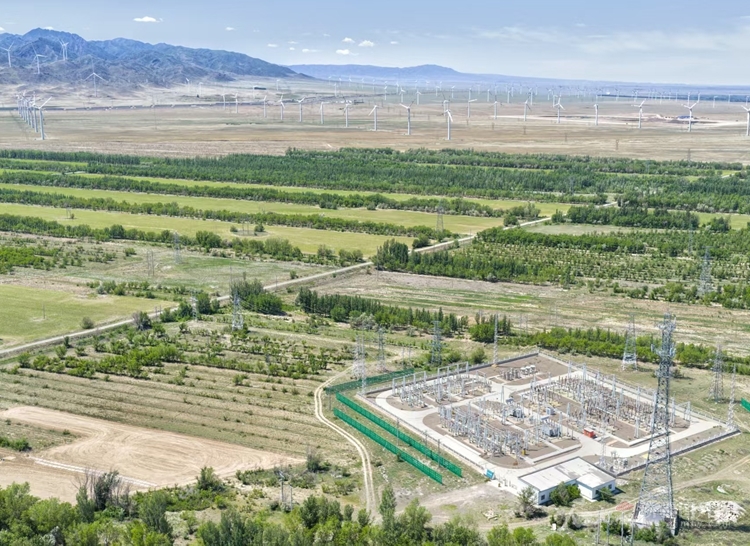Shiliuyun-Xinjiang Daily (Reporter Rayda) news: The Barluk Mountains in Tacheng Prefecture, northwest China's Xinjiang Uygur Autonomous Region, are faintly visible through the gaps in the clouds, while the Kulusitai Grassland stretches endlessly. At the Baktu Port, cargo trucks loaded with goods move orderly through the intelligent checkpoints. In the pilot development zone of the Xinjiang Tacheng Key Development and Opening-up Test Zone, rows of factories and the towering cranes on the construction sites of new projects complement each other. The blades of the wind turbines in the Laofengkou Wind Zone draw smooth arcs against the blue sky.
This fertile land, spanning 105,000 square kilometers, is bordered by the Kulusitai Grassland, the second-largest contiguous plain grassland in China, in the north, and embraces the hundred-mile picturesque landscape of the Tianshan Mountains in the south. The proportion of days with good air quality is over 98 percent and an average annual PM2.5 concentration of 14 micrograms per cubic meter. With 68 A-level scenic spots, Tacheng Prefecture has created a tourism map where "every corner is a scenic view." Known as the "city of accordions," it is also famous for its unique folk customs, such as "Shawan Dapanji (big plate chicken)" and the Russian-style red houses, all of which demonstrate the integration of diverse cultures here.
With a history of trade spanning over 260 years, the Baktu Port is the closest land port to a city in Xinjiang. Benefiting from the policies of the national border economic cooperation zone, it has become a magnet for the aggregation of various elements. The model of "direct connection of the place of origin + land port" is about to be launched. The policy dividends of the pilot transformation of the border trade and the local processing of imported goods continue to be released. Agricultural machinery and new energy products are being sold well in Europe and Asia through this "Northern Silk Road Channel."
Tacheng, as Xinjiang's "granary," "meat locker," and "oil vat," has one-tenth of Xinjiang arable land and one-seventh of its pastures, which give rise to a wealth of agricultural and sideline products. Boasting two of Xinjiang's major wind zones, Tacheng's average annual effective wind power generation time of 2,842 hours ranks first in Xinjiang. With a new energy development scale of 8.685 million kilowatts, green development holds limitless potential. Among the 73 types of minerals that have been identified, Tacheng has the highest reserves of molybdenum and chromium in Xinjiang." The "5+2" modern industrial system is being accelerated. From improving mineral resources to creating cultural tourism brands, from extending the textile and apparel industry chain to clustering bio-manufacturing, this land is bursting with an unprecedented vitality for development.
Nowadays, Tacheng sees coordinated development of ecology and economy. This northwestern border city is writing a story of high-quality development with its unique natural endowments, profound cultural heritage, and vigorous innovative vitality.

Photo taken on May 22, 2025 shows an overlooking view of Laofengkou Wind Zone in Tacheng Prefecture, northwest China’s Xinjiang Uygur Autonomous Region. (Photo by Jin Wei)

Photo taken on May 21, 2025 shows an overlooking view of Kulusitai Grassland in Tacheng Prefecture, northwest China’s Xinjiang Uygur Autonomous Region. Wetlands and grasslands interweave, and cattle and sheep forage freely, showing a picturesque view. (Photo by Chen Wen)

Photo taken on May 22, 2025 shows wind turbines stand on the hillside in Laofengkou Wind Zone in Tacheng Prefecture, northwest China’s Xinjiang Uygur Autonomous Region. (Photo by Zhang Yun)

Photo taken on May 22, 2025 shows people of various ethnicities dressed in their ethnic costumes gather at the foot of the Barluk Mountains in Tacheng Prefecture, northwest China’s Xinjiang Uygur Autonomous Region. (Photo by Ren Shaowu)

Photo taken on May 21, 2025 shows a worker inspects the impeller at the final assembly workshop of Jinfeng Wind Power Equipment Co., Ltd. in Tacheng Prefecture, northwest China’s Xinjiang Uygur Autonomous Region. (Photo by Jin Wei)

Photo taken on May 23, 2025 shows the Tacheng-Emin 750 kV power transmission and transformation project is constructed at an accelerated pace. (Photo by Jin Wei)

Photo taken on May 23, 2025 shows the construction of the project for medium- and high-voltage forming foil used in aluminum electrolytic capacitors by Xinjiang Xinda Technology Co., Ltd. in Emin County proceeds smoothly, with a worker carrying out equipment debugging. (Photo by Zhang Yun)

Photo taken on May 22, 2025 shows an overlooking view of Baktu Port in Tacheng Prefecture, northwest China’s Xinjiang Uygur Autonomous Region. (Photo by Jin Wei)

Photo taken on May 22, 2025 shows an overlooking view of Baktu Port in Tacheng Prefecture, northwest China’s Xinjiang Uygur Autonomous Region on the early morning. (Photo by Li Xiangdong)
(A written permission shall be obtained for reprinting, excerpting, copying and mirroring of the contents published on this website. Unauthorized aforementioned act shall be deemed an infringement, of which the actor shall be held accountable under the law.)









